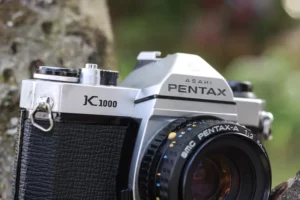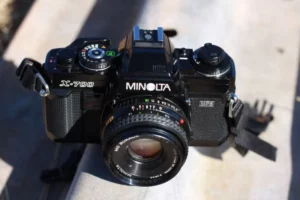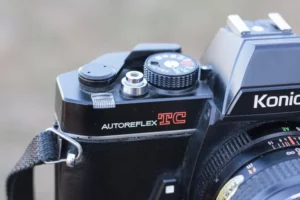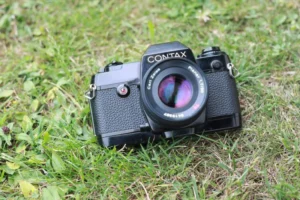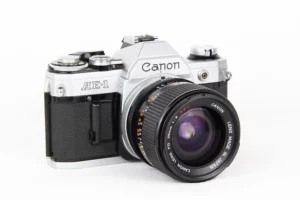Pentax Spotmatic F Review: Leica quality in a SLR?
Last Updated on January 28, 2023
The Pentax Spotmatic F fell into my hand rather by accident. It went under the hammer at an auction held by a collection agency.
The price was okay, so I grabbed it. I usually do a little research on the cameras I buy, but I had to make a spontaneous decision here.
I’ve wanted to try a Pentax for a long time. And the Spotmatic is by its reputation one of those Pentax cameras that you should definitely have in your hands.
So I stood there with a camera and a 55mm lens and didn’t know whether it was a bad buy or a stroke of luck.
But first I wanted to find out which camera I had actually bought. Pentax? Clear! Spotmatic? Okay… Asahi? Hmm, well. But from the front.
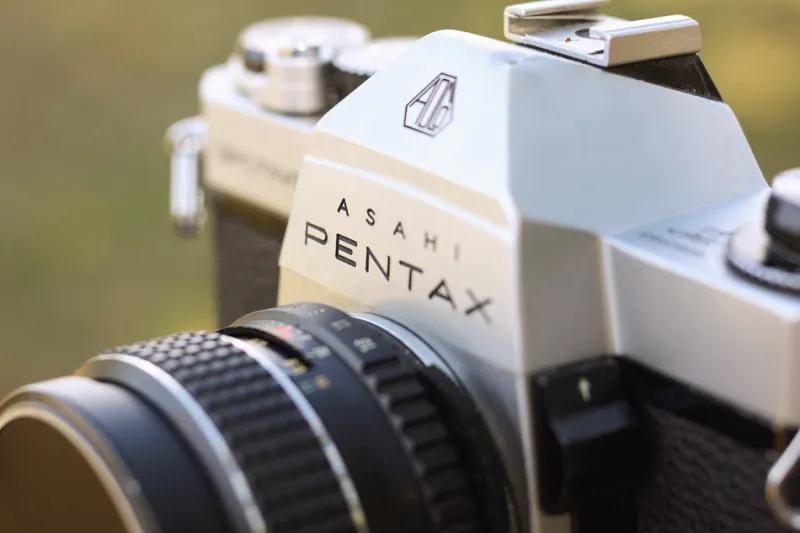
Table of Contents
Asahi Optical Co.’s First Steps
As early as 1919, a company for optical devices was established under the name Asahi Kogaku Kogyo. Initially still a glasses producer, only a short time later she also produced projection lenses, binoculars and finally camera lenses.
Among other things, a company that would later become known as Minolta was also supplied with lenses. However, after changing its name to Asahi Optical Co. in 1938, it would be another 14 years before Asahi released its first 35mm camera.
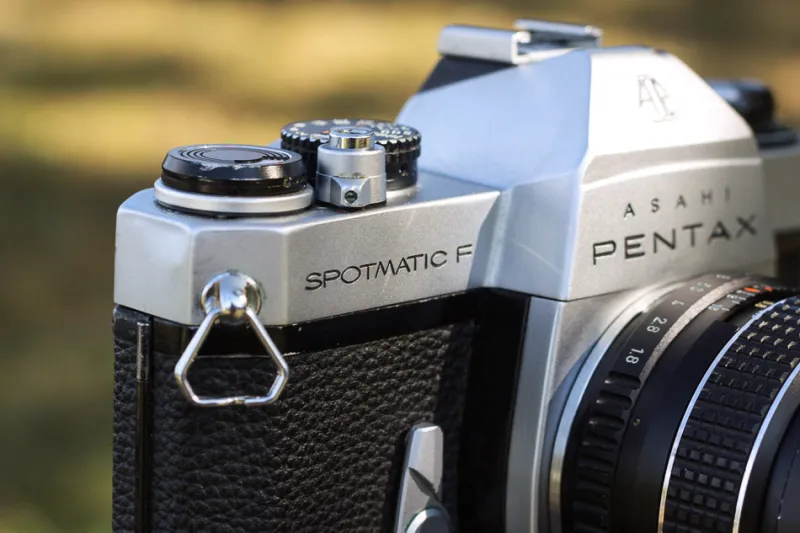
The predecessor – Asahiflex
With the Asahiflex, later referred to as the Asahiflex I to distinguish it from the successor models, Asahi celebrated its first successes.
They earned further merits with the Asahiflex IIB. While the Asahiflex is an SLR, it lacks the typical feature when we talk about SLRs today – the viewfinder hill.
Because she only had a waist-level viewfinder to look through the lens. As an alternative, it also offered a through-view finder.
In contrast to today’s SLRs, however, this was mounted on the side, as with rangefinders, and therefore you did not look through the lens.
The name “Pentax”
As early as 1957, Asahi built an SLR with a pentaprism viewfinder. In order to do justice to this circumstance, the “penta” should also appear in the name.
Thus the Asahi Pentax was born. Based on the name “Contax” used by Carl Zeiss cameras. In any case, a certain affinity with one of the most respected manufacturers couldn’t hurt.
Rumor has it that Carl Zeiss also played an important role in the naming. The Pentax name still belonged to Carl Zeiss (West) and to get in the way of their GDR brother, they sold the name to Asahi.
Because Carl Zeiss (East) had christened their cameras “Pentacon”.
The Spotmatic – a bestseller
Three years after the Asahi Pentax, a successor was presented in 1960, but it was not available for purchase until 1964. The name: Asahi Pentax Spotmatic.
It was to be a blockbuster for Asahi Optical Co. Asahi Pentax has sold more than four million copies of the various Spotmatic cameras over the years. More than Canon and Nikon combined, some claim even more than all other manufacturers combined.
Anyway, it was the breakthrough for Asahi Optical Co.
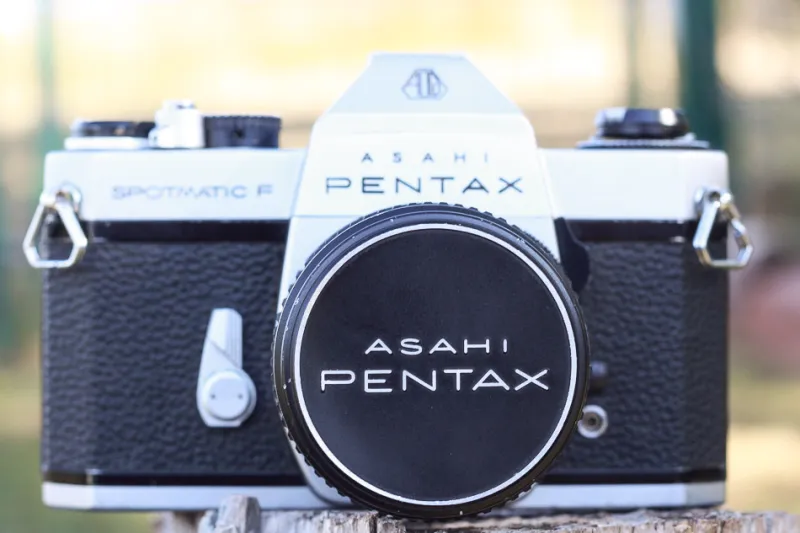
Finally TTL
Asahi already had a lot in its program that was in high demand. Above all, first-class lenses.
With the Spotmatic* they now also had a first-class chassis on offer. At that time, cameras with exposure meters had long been en vogue. However, it was always somehow done externally using our own exposure meters, which were located somewhere on the camera.
Asahi Optical CO. found a way for this exposure metering to be done through the taking lens. TTL exposure metering was born.
Nikon had previously shown a prototype. But it was a rangefinder camera.
The Spotmatic was the first SLR to be presented with TTL metering. However, the first commercially available SLR with TTL metering was the Topcon RE Super.
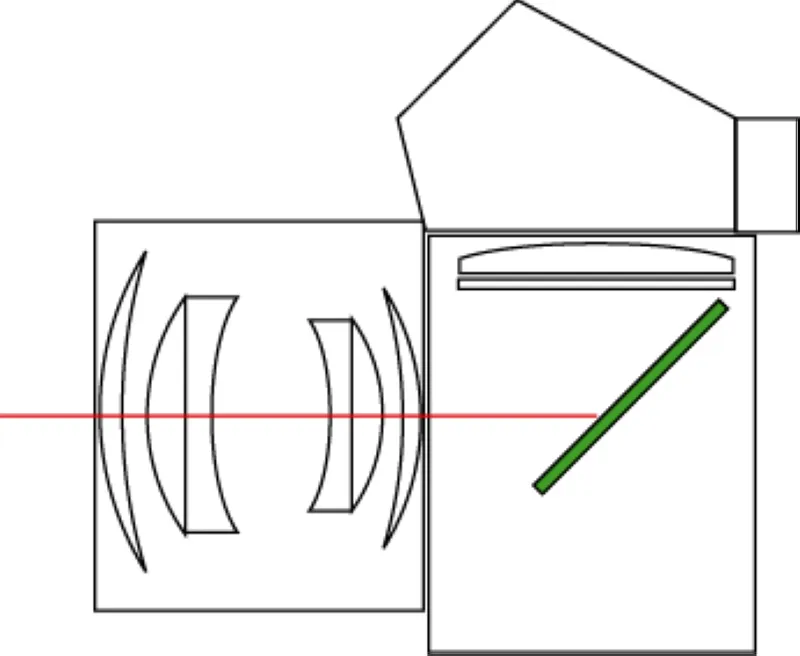
The (new) triggering process of the Spotmatic F
With the original Spotmatic, the triggering process was as follows.
First, the focus had to be set with the aperture open.
This step is usually carried out first because, firstly, the focal plane has to be set more precisely with an open aperture and secondly, the ground glass screen is the brightest.
Then a lever was pushed up. This activated the exposure meter and dimmed at the same time.
Now the correct exposure had to be set. Ultimately, when all of this happened, the trigger was pulled.
The Spotmatic F eliminated the extra step of activating and dimming the light meter. This happened automatically thanks to the spring shutter.
SMC is the magic word
In order for the Pentax Spotmatic F to be able to carry out its TTL open aperture measurement correctly, new lenses were needed.
Communication between camera and lens is essential in this case. This can happen electronically or mechanically.
Pentax decided to get the information via a pin on the lens. The M42 bayonet was not originally designed for this, which is why the switch to the K bayonet should take place shortly afterwards.
The lenses with a pen were given new names to make them easier to distinguish.
While the old variants had the names “Auto-Takumar” and “Super-Takumar”, Asahi immediately incorporated the new multiple coating into the new names.
From 1971, the designation “Super-Multi-Coated Takumar” was created and from 1972 abbreviated “SMC Takumar”.
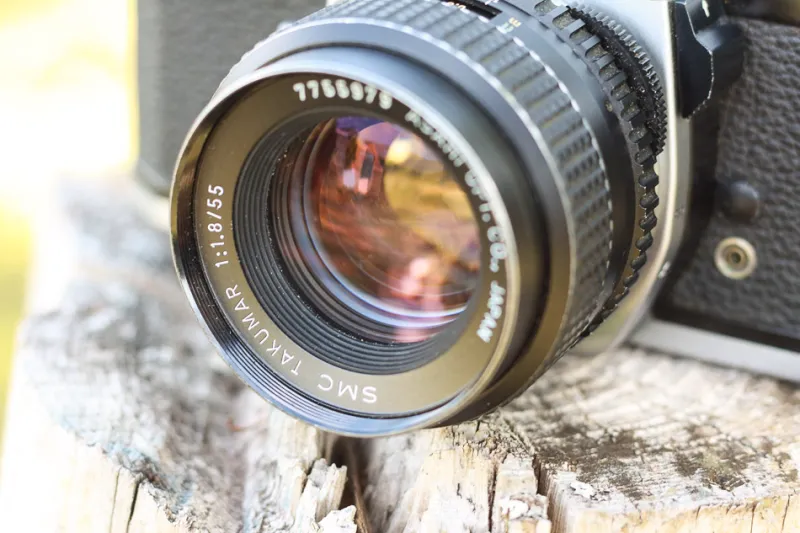
A little problem
The CdS integral metering of the Spotmatic F has a small problem. And I don’t mean that, despite the name Spotmatic, it is not a spot exposure metering at all, but a centre-weighted metering.
The problem is that the Spotmatic does not have an on/off switch for exposure metering. So this runs continuously. And eats up batteries all the time.
Luckily, a property of CdS cells is that current is only consumed when there is light.
Therefore, all users of a Spotmatic F should think about their lens caps. Because the attached cover prevents excessive stress on the battery.
A non-problem
Readers who enjoy shooting with cameras from the 1960s and 70s will know where this is headed. The well-known mercury nuisance.
Cameras like the Spotmatic F require these mercury batteries with a voltage of 1.35V. If you take the 1.5V cells available today, they are the same size, but the light meter will show incorrect values, such as e.g. B. with the Konica Autoreflex TC.
But who knows, maybe the Asahi engineers could already see into the future. Luckily they used a Wheatstone bridge. Now I’m not an electrical engineer, but in short, the absolute voltage value is not relevant for this circuit, but only a voltage difference between two voltage dividers.
The good news for us photographers: It doesn’t matter what the voltage is on the battery: whether it’s 1.35V or 1.5V, the exposure meter always works just as well.
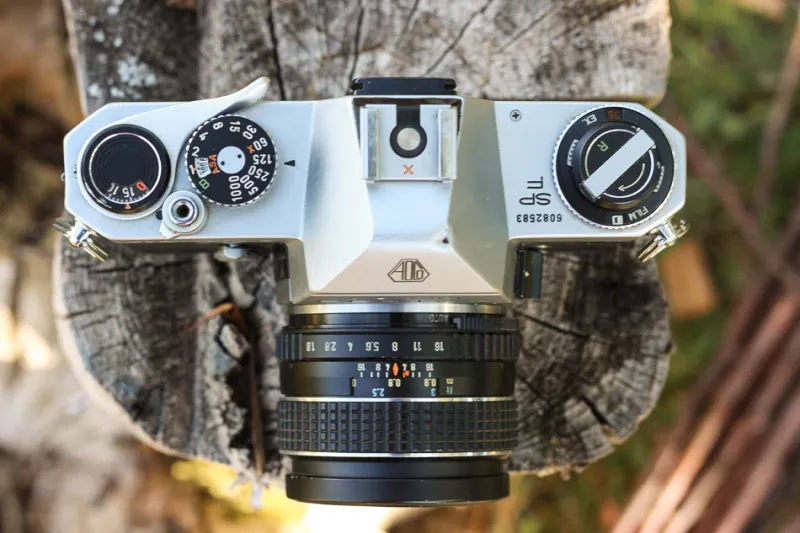
A highlight – the feel
Why do we dare to take pictures with cameras that are 50 years old or older?
Every digital camera of the last 10 years (at least) takes technically perfect photos at the touch of a button.
But there are things that the latest models just don’t have. Which camera still manages with 3-4 operating elements and makes taking photos the seemingly simplest thing in the world?
Choose aperture, choose time, press shutter button, done.
Add to that the gentle click as the times click into place as the wheel spins. The delicate purr of the all-metal film transport lever.
The exact response of the trigger with just the right resistance.
The smooth resistance when focusing the lens and the confidence-inspiring click of the aperture ring.
The Spotmatic F has all of that. As far as the feel is concerned, it is in no way inferior to my Leica M6 and that is saying something.
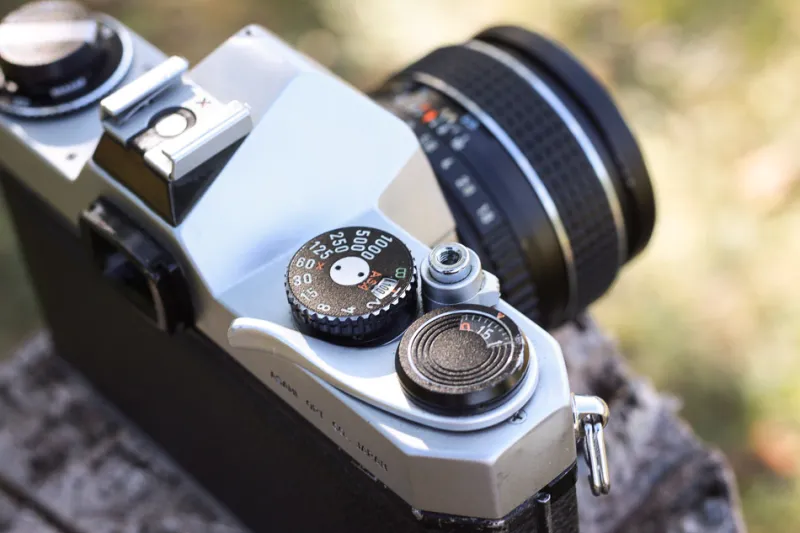
The exterior of the Spotmatic F
As I write this text, the Spotmatic F is lying next to me on the desk and somehow I can’t take my eyes off it.
It shines with a matt silvery sheen and has nevertheless carried its quirks from the last almost 50 years. The front shows everything important in a beautiful, sans serif font: Asahi Pentax Spotmatic F.
There’s also an all-metal self-timer lever in the usual location. On the other side of the bayonet housing, there isn’t an unlocking button, as you would expect. The M42 doesn’t have that, due to the rotary thread.
There is the anti-glare button so that older Takumar lenses, or of course all other M42 lenses without a pin for aperture transfer, can also be used on the Spotmatic F.
There is also an X-Sync port for connecting electronic flashes and an FP port for flash bulbs according to the FP standard.
Spartan, but with attention to detail
On the back, apart from the viewfinder, there is only the engraved “Asahi Opt. Co. Japan“. As spartan as it gets.
On the underside, next to the battery compartment, there is a tripod thread and the rewind button. An interesting detail is the small dot on the rewind knob that serves to check that the film is actually winding into the cartridge while the rewind crank is being turned.
It’s details like this that bring a smile to my face.
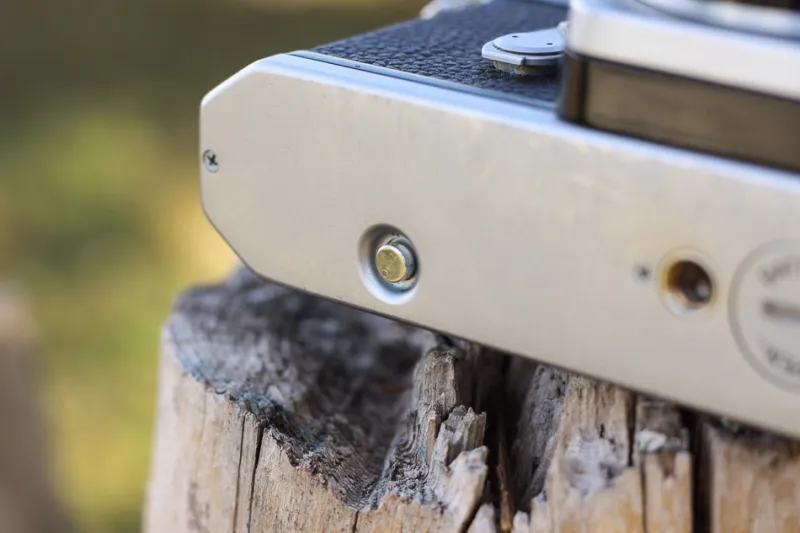
A painful experience
The rewind crank, also made entirely of metal, is located on the left shoulder of the Spotmatic F.
Underneath, two discs are cleverly embedded, which display the type of film, black and white, color or tungsten, as well as the length of the film, 36 or 20, in a small window on the front and back.
Nowadays there are usually only 24 films, but I think you can live with 20.
What bothered me is that the inner mechanism that keeps the film type turning is a bit stiff. If, like me, you don’t think twice, you try to turn it further with your fingernail.
The pointed, corrugated surface sawed my fingernail clean.
However, if I had thought for 5 seconds, I would have thought of lifting the rewind handle and then easily selecting the film type. Well, learning through pain.
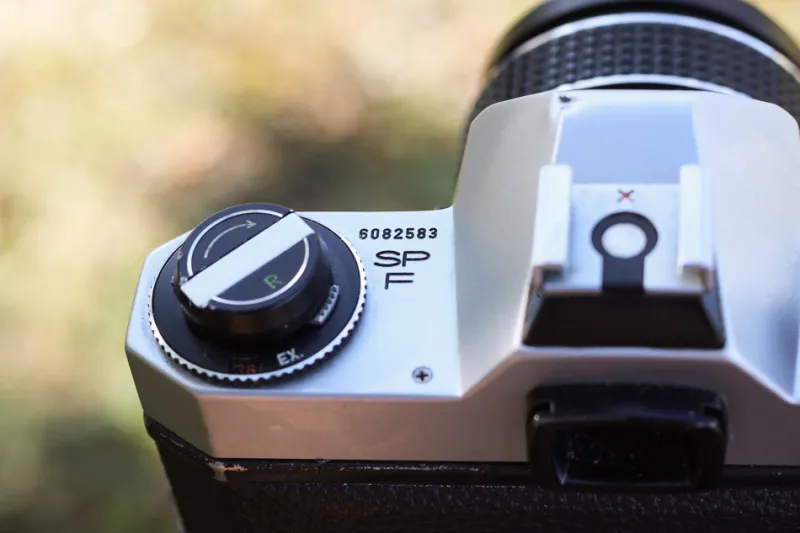
The Pentax layout
The right shoulder of the Spotmatic F offers the ergonomically first-class Pentax layout.
Combined ASA/time wheel on the left, film transport lever with integrated image display on the right and the shutter release including release lock in the middle at the front.
Perfect, because your thumb is automatically on the rewind lever and your index finger on the shutter release, while you can set the shutter speed with the other hand. Except for the shutter lock, operation is a joy.
This is extremely difficult. That could of course be a problem with my copy, but I still prefer not to use it, otherwise I’m missing another fingernail.
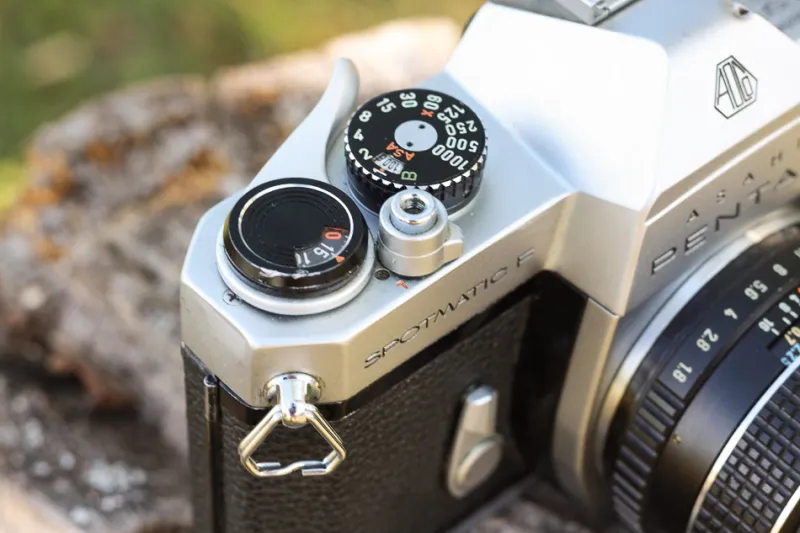
The viewfinder – a sticking point
A sticking point is the viewfinder of the Spotmatic F in my case in two senses.
Because at some point in its long life, my camera took a hit on the head, which is reflected in an unsightly dent. The pentaprism is also cracked. Luckily only outside of the visible range.
I only noticed it when I had already completely missed the first film. But the real sticking point for me is something else.
It wasn’t the extremely practical exposure display, which is really easy to use, that bothered me, but the missing split image distance measurement. The Spotmatic relies on a Fresnel lens and microprism ring. It’s actually a microprism point in the center of the screen.
There’s no question: it’s also good to focus with it, but I find it easier with a split image. Well, who’s perfect?
50mm or 55mm?
One often finds the Pentax cameras with the somewhat unusual-looking standard lenses with a focal length of 55mm. Now normal lenses are not equal to 50mm.
Mathematically, 43.3mm is even the normal focal length for 35mm. This already shows that the 55mm Takumar lenses sit at the upper end of the focal length scale for normal lenses.
Why all this? When you look through the viewfinder, the answer is obvious. Because with a 55mm lens, the Spotmatic F has a viewfinder magnification of exactly 1x.
This means that in terms of magnification it makes no difference whether I look through the viewfinder or past the camera. Both are shown in the same scale.
Of course, that’s great if I can still see the surroundings with the other eye while one eye is on the viewfinder and focusing.

Conclusion on the Pentax Spotmatic F
A camera like a painting. Honestly, I like her so much. Of course it’s a matter of taste, but somehow you have to approach the conclusion.
In any case, it is a pleasure to operate the Spotmatic F. Sure, it’s not the lightest, but all the metal used weighs more than plastic. Still, it’s not overly heavy.
I can (almost) recommend the camera to everyone. There are really only 2 points that, in my opinion, could deter a willing buyer.
On the one hand, the quasi compulsion to always put on a lens cap if you don’t want to put too much strain on the batteries. On the other hand, the missing split image rangefinder.
This may be petty on my part, someone else might see it completely differently, but it bothered me a bit, especially when you consider that focusing is part of pretty much every shutter release process.
The Spotmatic F – a purchase recommendation?
If someone scrolled straight to the conclusion, one might think that the Spotmatic F left a
mixed impression. To a certain extent this is of course the case.
Nevertheless, a list that would speak in favor of the purchase would be a lot longer than the two points that might speak against it.
For my part, I’ve got a taste for it, but I already have another camera from Asahi Pentax in mind that could inspire me even more. But more on that soon.
